
Get your FREE 30-day trial.
Please complete all fields.
Over the past few weeks, we've seen a number of great studies come out declaring that in 2014 marketers will be focused on customer data and retention more than ever before. ExactTarget's 2014 State of Marketing study confirms that, for the first time ever, "the top lifecycle challenge is no longer acquiring new subscribers but instead it's how to drive engagement and ongoing revenue." Additionally, WBResearch 2014 Customer Experience survey said that the majority of marketers are planning to invest in customer analytics that help them improve customer experience.
Today's marketers need to pay attention to the second half of the funnel. It's no longer just about filling the funnel; we have to provide stunning experiences and optimize every touchpoint.
But where do you start? Measuring customer loyalty isn't the easiest task. At BigDoor, we've been focused on customer loyalty and analytics for years, and we've created a model that can be adopted by any organization to better understand loyalty.
BigDoor's loyalty measurement framework
While there are dozens of specific metrics you can look at to understand whether someone is engaged with your brand, when it comes to loyalty there are five key categories you need to pay attention to: registration, frequency, conversions, advocacy, and rewards.
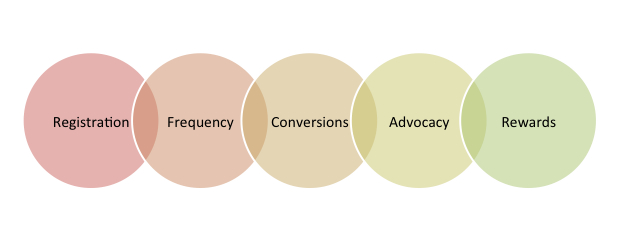
To really understand how loyal your community and customers are, you need to track all five of these categories. And on top of that, you need to play in cohort marketing. Sound scary? Don't worry, we got ya covered. Let's jump in.
What do we mean by "Registration?"
Registration means your anonymous users are signing up for either your community or a loyalty program. After all, it's impossible to develop a relationship with someone if they haven't told you who they are. The truth is, getting your anonymous visitors or customers to register is at the heart of driving lifecycle marketing.
By now, we all understand how critical it is to personalize a user's experience, but personalization is impossible if you don't have user data. We need to give users a reason to want to tell us who they are, on every device they own and at every touchpoint they have with our brands. By encouraging users to register for either a community or a loyalty program, you can collect user behavior, engagement, and demographic data. This data is how you build beautiful, personalized experiences that delight customers and increase their loyalty to your brand.
TIP: There are many ways to get more visitors and customers to register. Here are some of our favorites...
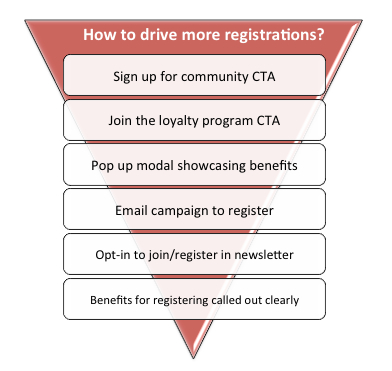
What do we mean by "Frequency?"
Frequency speaks to the behavior of a visitor or customer. How often do they come back? How often are they engaging with your site, content, brand, and more? We want visitors and (hopefully) customers to come back often. This drives more engagement, more purchases, and ultimately leads to them being more loyal to your brand.
In addition to how often someone visits, you can also lump in the concept of "recency," which speaks to how often someone comes back in a pre-determined time period. By keeping an eye on how frequently your visitors and customers are coming back, you can establish an engagement baseline. This is critical when gauging how loyal a customer is to your brand.
TIP: There are many ways to increase customer visit frequency. Here are some of our favorites...
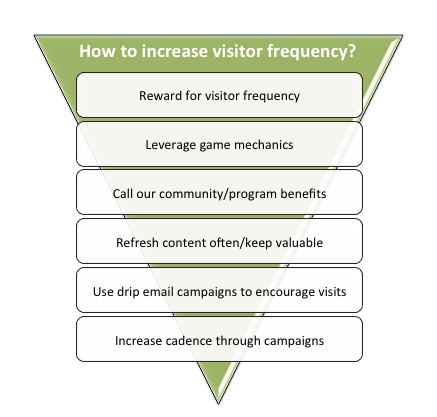
What do we mean by "Conversions?"
For our purposes here, a "conversion" is when a consumer completes an action that's valuable to the brand. As it relates to loyalty, we acknowledge there are two distinct camps of conversions: those that are revenue-based and those that are engagement-based.
Different loyalty campaigns have different goals. Sometimes we try to drive repeat purchases or transactions, and other times we try to drive engagement (like visiting a page, watching a video, downloading a resource, and so on). All of these actions are important for different reasons, and tracking them is a key part of determining how engaged someone is with your brand.
TIP: There are many ways to increase purchase-based and engagement-based conversions. Here are some of our favorites...
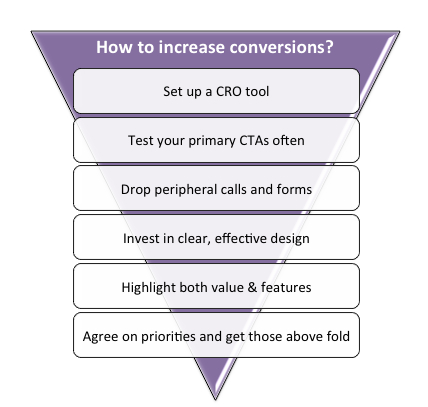
What do we mean by "Advocacy?"
Advocacy is when a consumer publicly vouches for a brand. Brand advocacy can be seen through a content share, a referral, or just mentioning a brand to a social circle. The rise of social media has given the consumer even more sway than before. Brands are working to tap into the power of social advocacy, knowing it's a great way to reach new audiences and compel them to join communities, make purchases, and more.
Many marketers think you can't easily encourage advocacy and therefore don't track it, but that simply isn't the case. We should absolutely be paying attention and tracking this as a key indicator of brand loyalty.
TIP: There are many ways to increase customer advocacy. Here are some of our favorites...

What do we mean by "Rewards?"
If customer loyalty had a smoking gun, rewards would be it. When we say rewards, we are referring to any time a gets something extra from the brand that goes above and beyond what is expected. Sometimes this is done when a brand rewards a customer with a tangible reward, a coupon, an experience they can't get any other way, or sometimes it's just a valuable resource.
If you aren't measuring how many times your customers are both offered rewards and take advantage of them, you're missing a huge piece of measuring loyalty. It's this moment of exchange that solidifies reciprocal loyalty between a brand and a customer. The customer needs to feel appreciated.
TIP: There are many ways to increase participation in rewards. Here are some of our favorites...

Hopefully this framework gives you a sense of how to approach measuring customer loyalty. It really is more complex than simply measuring how often a customer purchases from you and how many dollars they make your brand. As marketers, we need to evolve our analytical approach to measuring loyalty. These five categories are a great starting point.
But how does it all come together? Two words: cohort marketing.
What is "cohort marketing?"
Cohort marketing means breaking your audience into groups based on their similarities, behaviors, or other attributes, and tailoring your marketing efforts accordingly. It seems simple, but this piece is overlooked more than you would think, resulting in "spray and pray" marketing to the masses.
Marketers are comfortable doing this during the acquisition phase, but it is so powerful when applied and used during the retention/loyalty phases. Cohort analysis stresses that everything is broken down and analyzed on a per user basis, which results in some fantastic marketing insights and opportunities. everything needs to be broken down to a per-user basis.
You can take the framework above and use it to help you understand your customer base by leveraging the power of cohorts for lifecycle marketing. It begins looking a little something like this:

As you can see in the above view, Cohort 4 is likely to be the most loyal. They are registered, come back often, convert average, advocate average, and are rewarded often. Companies can get much more granular with these weightings, but even when working off of a yes/no for registered and then low/medium/high for the other categories, this framework helps you identify the cohort of your customers that are most loyal.
Overwhelmed? Don't be. The truth is you are likely already measuring a number of the counts involved with understanding registration, frequency, conversions, advocacy, and rewards. From there, it's all about organizing your data and building out your cohorts. Depending on your company's current primary business objective, you might want to stress one of the categories more than the others right now.
Example time:
Before you begin, you must define your team's loyalty goals. Perhaps "increasing social advocacy" is a priority for your team right now. By understanding where your customers fall in a spectrum, you can begin testing campaigns and making progress. Looking at the same cohorts above, let's pull out those cohorts that are advocating the most on your brand's behalf:
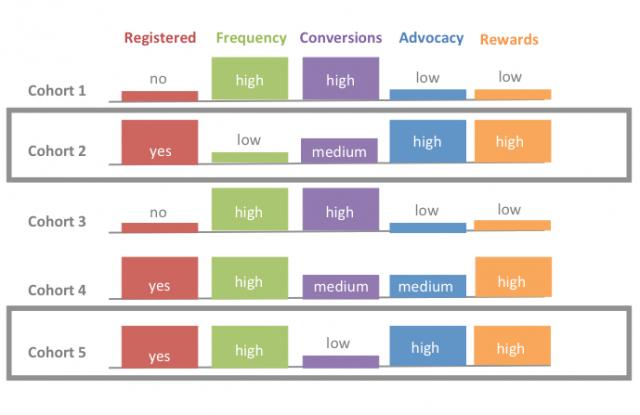
From here, you can effectively profile those cohorts. From the above view, it looks like Cohorts 2 and 5 are the most active brand advocates. We can deduce that each cohort is full of customers who are both registered and participate heavily in rewards. From that, you can assume that encouraging registration and stressing how customers can be rewarded encourages advocacy. You can start to build marketing campaigns around different touch points and test them to ultimately drive your key business objective.
Ultimately, the above chart shows that if you encourage Cohorts 1 and 3 to register for your community or loyalty campaign, you can actually turn them into brand advocates. This last step is exactly what we mean by the power of cohort marketing. It enables you to build profiles, dive deep into the data, and then use it to achieve your goals.
You can see how powerful understanding these five pieces can be in prioritizing your loyalty marketing efforts. However, if you don't establish your benchmark across these key pieces, you can't actually measure if your marketing is making a difference on your customer's lifecycle and their level of loyalty.
But really, where do I start?
Still not quite sure where to start? Here at BigDoor, we are a little nutty about all these data points, but specifically around the stages of "registration" and "rewards." If you aren't sure what to start with, we recommend finding a way to collect more information on your customers and a way to say thank you when they do invest in your brand. We believe these two bookend categories to be the ones that make the biggest impact on the middle categories.
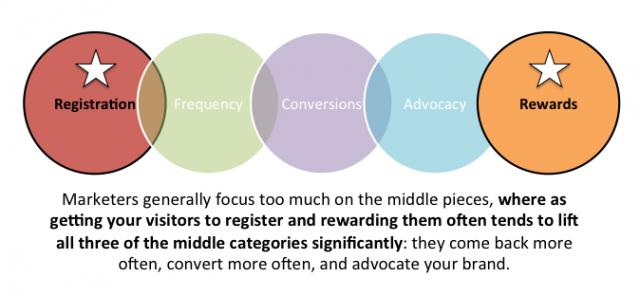
Let's wrap this party up
We know that measuring customer loyalty can be hard. For years, companies have struggled to understand whose responsibility it is to keep an eye on this important part of the funnel, and also how to measure it appropriately. We believe that marketers are best suited to understand the customer lifecycle and that many of the pieces they already measure are critical in gauging loyalty.
The BigDoor loyalty measurement framework will likely evolve over time, but it has helped some of the biggest brands in the world benchmark customer loyalty and succeed in increasing it.
In today's noisy and competitive ecosystem, developing customer loyalty can be a huge advantage. We'd love to hear your thoughts or suggestions in the comments below!